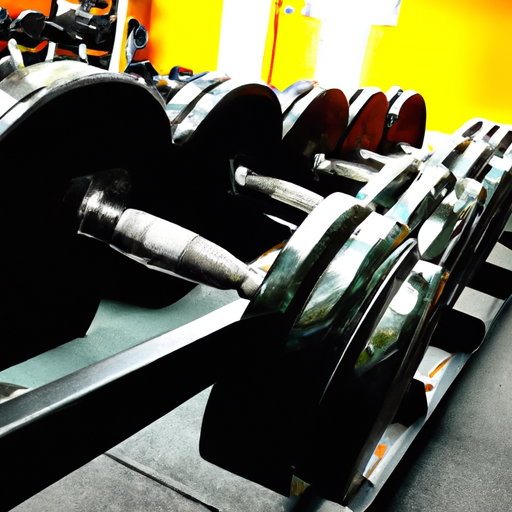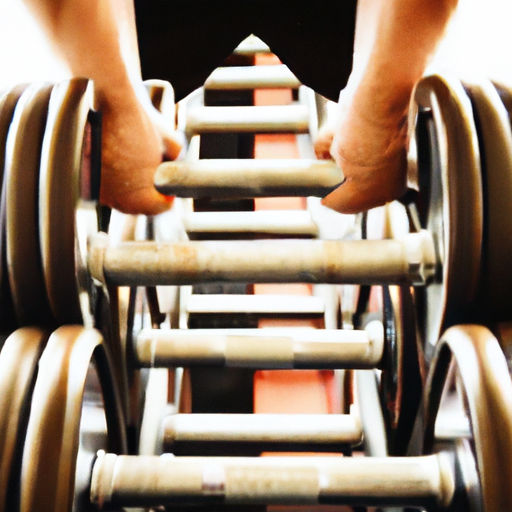When it comes to choosing the right weightlifting barbell for your needs, there are a few key factors to consider. From the type of exercises you plan on doing to your personal fitness goals, it’s important to find a barbell that meets your specific requirements. Whether you’re a beginner looking to build muscle or an experienced lifter aiming to increase your strength, this article will guide you through the process of selecting the perfect weightlifting barbell for you.

1. Consider Your Training Goals
When choosing a weightlifting barbell, it’s important to consider your training goals. Are you primarily focused on strength training, Olympic weightlifting, or powerlifting? Understanding your training goals will help you determine the type of barbell that is best suited for your needs.
1.1 Strength Training
If your main goal is strength training, you’ll want to look for a barbell that is designed to handle heavy weights and provide stability during lifts. A barbell with a higher weight capacity and a sturdy construction will be necessary to support the demands of strength training exercises such as squats, deadlifts, and bench presses.
1.2 Olympic Weightlifting
For those interested in Olympic weightlifting, a specific type of barbell is required. These barbells are designed to allow for fast and explosive movements, such as the snatch and clean and jerk. They typically have more whip and spin in the sleeves to accommodate the dynamic nature of Olympic lifts.
1.3 Powerlifting
Powerlifting focuses on the three main lifts: squat, bench press, and deadlift. If powerlifting is your primary training goal, you’ll want to consider a barbell that is specifically designed for this type of training. Powerlifting barbells are typically stiffer and have less whip compared to Olympic weightlifting barbells. They also often have a more aggressive knurling pattern for better grip during heavy lifts.
2. Determine the Type of Barbell
After considering your training goals, it’s time to determine the type of barbell that will best suit your needs.
2.1 Standard Barbell
A standard barbell is the most basic type of barbell and is generally used for general fitness and light weightlifting. It has a maximum weight capacity of around 200-300 pounds and may not be suitable for heavy lifting or advanced training techniques.
2.2 Olympic Barbell
An Olympic barbell is the standard barbell used in Olympic weightlifting. It is designed to handle heavy loads and has a maximum weight capacity of around 1,000-2,000 pounds. Olympic barbells have rotating sleeves that allow for the bar to spin during lifts, reducing the strain on the lifter’s wrists and allowing for smoother movements.
2.3 Powerlifting Barbell
A powerlifting barbell is specifically designed for powerlifting competitions and heavy strength training. It is similar to an Olympic barbell in terms of weight capacity but typically has a stiffer and less flexible shaft. Powerlifting barbells often have a more aggressive knurling pattern for better grip during heavy lifts.
3. Check the Barbell Specifications
Once you have determined the type of barbell that suits your training goals, it’s important to check the specifications of the barbell before making a purchase.
3.1 Barbell Length
The length of a barbell can vary and should be considered based on your individual needs. Olympic barbells typically measure 7 feet in length, while standard and powerlifting barbells may be slightly shorter. Ensure that the length of the barbell allows for enough space to comfortably load plates for your desired exercises.
3.2 Barbell Diameter
The diameter of the barbell is another important specification to consider. Thicker barbells, typically with a diameter of 28-32mm, are often preferred for strength training and powerlifting as they provide a greater grip challenge. Olympic barbells, on the other hand, tend to have a slightly thinner diameter of 28-29mm, which allows for better flexibility during dynamic lifts.
3.3 Barbell Weight Capacity
The weight capacity of a barbell refers to the maximum amount of weight it can safely hold. This is an important consideration for those who plan to lift heavy or progress in their strength training. Olympic barbells typically have a higher weight capacity, ranging from 1,000 to 2,000 pounds, while standard barbells may have a lower weight capacity of around 200-300 pounds.

4. Evaluate the Barbell’s Knurling
The knurling on a barbell refers to the texture or grip pattern on the shaft of the bar. It plays a crucial role in providing grip during lifts and preventing the bar from slipping out of your hands. When evaluating the knurling of a barbell, consider both the knurling pattern and intensity.
4.1 Knurling Pattern
The knurling pattern refers to the design or texture of the grip on the barbell. Some barbells have a more aggressive knurling pattern with deeper, sharper grooves, while others have a smoother, less aggressive pattern. The choice of knurling pattern ultimately comes down to personal preference and the specific demands of your training.
4.2 Knurling Intensity
The intensity of the knurling refers to how sharp or aggressive the grip feels on the barbell. A more intense knurling provides a stronger grip but may also feel rougher on the hands. This can be beneficial for heavy lifts where a secure grip is essential. However, if you have sensitive hands or prefer a less aggressive grip, a barbell with a lighter knurling intensity may be more suitable.
5. Consider the Barbell’s Sleeve
The sleeves of a barbell are the rotating parts located at each end of the bar. They play a crucial role in allowing the bar to spin during lifts, reducing the strain on the lifter’s wrists and improving the efficiency of movements. When considering the barbell’s sleeves, factors such as length, rotation, and coating should be taken into account.
5.1 Sleeve Length
The length of the sleeves can vary depending on the type of barbell. Longer sleeves are generally preferred for Olympic weightlifting as they allow for more plates to be loaded and provide greater room for the bar to spin. Powerlifting and standard barbells may have shorter sleeves as they typically do not require as many plates for the exercises performed.
5.2 Sleeve Rotation
Sleeve rotation refers to how freely the sleeves rotate around the shaft of the bar. Smooth rotation is essential for Olympic weightlifting as it allows for efficient spins during lifts. Look for barbells with high-quality needle bearings or bushings that provide smooth rotation without any wobbling.
5.3 Sleeve Coating
The coating on the sleeves of a barbell can impact its durability and performance. Hard chrome coatings are commonly found on high-quality barbells as they offer excellent resistance to corrosion and provide a smooth, reliable spin. Other coatings such as zinc or black oxide may offer some level of protection but may not be as durable in the long run.
6. Assess the Barbell’s Material
The material of the barbell shaft plays a significant role in its durability, performance, and feel. Three common materials used for barbells include steel, stainless steel, and chrome.
6.1 Steel Barbell
Steel barbells are the most common and affordable option. They are durable and can withstand heavy loads, making them suitable for strength training and powerlifting. However, steel barbells may be prone to rust if not properly cared for, so regular maintenance is important.
6.2 Stainless Steel Barbell
Stainless steel barbells offer excellent corrosion resistance, making them an ideal choice for those who train in humid environments or are prone to sweating. They are also known for their smooth and comfortable feel. However, stainless steel barbells tend to be more expensive compared to their steel counterparts.
6.3 Chrome Barbell
Chrome barbells have a sleek and shiny appearance and also provide good corrosion resistance. They are often more affordable than stainless steel barbells but may not have the same level of durability or resistance to scratches or chipping.
7. Consider Barbell Maintenance
To ensure the longevity and optimal performance of your chosen barbell, it’s essential to consider its maintenance requirements.
7.1 Corrosion Resistance
If you train in a humid environment or tend to sweat a lot, choosing a barbell with excellent corrosion resistance is crucial. Stainless steel and chrome barbells are known for their resistance to rust and corrosion and may require less maintenance compared to steel barbells.
7.2 Oxidation Prevention
Regular cleaning and maintenance can help prevent oxidation and extend the lifespan of your barbell. Applying a thin coat of oil or a specialized barbell maintenance product after each use can help protect the barbell from moisture and prevent rust from developing.
7.3 Barbell Warranty
Another aspect to consider is the warranty provided by the manufacturer. A longer warranty period indicates that the company has confidence in the quality and durability of their product. Look for barbells that come with a warranty to ensure you are protected against any manufacturing defects or premature damages.
8. Take Your Budget into Account
Weightlifting barbells can vary greatly in price, so it’s important to establish a budget before making a purchase. Consider your training goals, frequency of use, and long-term commitment to weightlifting when deciding how much you are willing to invest in a high-quality barbell. While affordable options are available, it’s important to prioritize quality and durability to ensure a safe and effective training experience.
9. Consider Additional Features and Attachments
In addition to the main features discussed above, there are several additional features and attachments that may enhance your weightlifting experience.
9.1 Barbell Knurling Markings
Some barbells come with knurling markings that indicate hand placement for different lifts. These markings can be helpful for beginners who are still learning proper technique or for those who prefer to have a visual guide.
9.2 Barbell Whip
Whip refers to the flexibility or bendiness of the barbell shaft. Some lifters prefer a barbell with more whip as it can help with explosive Olympic lifts. Others prefer a stiffer barbell for higher stability during heavy strength training. Consider your training goals and personal preferences when deciding on the level of whip that is right for you.
9.3 Barbell Center Knurling
Center knurling refers to the knurling located in the center of the barbell shaft. It can provide extra grip and stability during certain lifts, such as back squats. If you frequently perform exercises where the bar rests against your neck or shoulders, consider a barbell with center knurling for added security.
10. Seek Expert Advice
When in doubt, don’t hesitate to seek expert advice. Talk to trainers or experienced weightlifters who can provide recommendations based on their knowledge and experience. They can offer valuable insights and help you navigate the vast array of options available on the market.
Choosing the right weightlifting barbell is crucial for achieving your training goals and ensuring a safe and effective lifting experience. By considering your training goals, evaluating specifications, assessing the barbell’s knurling and sleeve, and taking factors like material, maintenance, budget, and additional features into account, you’ll be well on your way to selecting the perfect barbell for your needs. Happy lifting!
